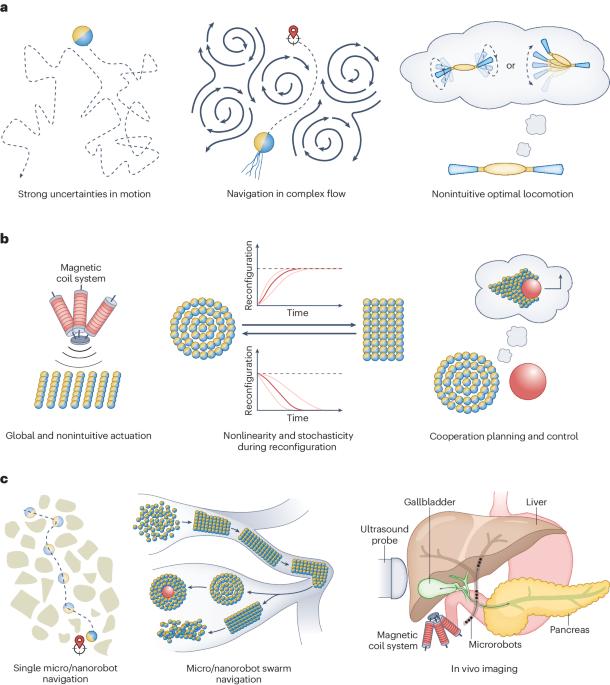Machine learning for micro- and nanorobots
IF 23.9
1区 计算机科学
Q1 COMPUTER SCIENCE, ARTIFICIAL INTELLIGENCE
引用次数: 0
Abstract
Machine learning (ML) has revolutionized robotics by enhancing perception, adaptability, decision-making and more, enabling robots to work in complex scenarios beyond the capabilities of traditional approaches. However, the downsizing of robots to micro- and nanoscales introduces new challenges. For example, complexities in the actuation and locomotion of micro- and nanorobots defy traditional modelling methods, while control and navigation are complicated by strong environmental disruptions, and tracking in vivo encounters substantial noise interference. Recently, ML has also been shown to offer a promising avenue to tackle these complexities. Here we discuss how ML advances many crucial aspects of micro- and nanorobots, that is, in their design, actuation, locomotion, planning, tracking and navigation. Any application that can benefit from these fundamental advancements will be a potential beneficiary of this field, including micromanipulation, targeted delivery and therapy, bio-sensing, diagnosis and so on. This Review aims to provide an accessible and comprehensive survey for readers to quickly appreciate recent exciting accomplishments in ML for micro- and nanorobots. We also discuss potential issues and prospects of this burgeoning research direction. We hope this Review can foster interdisciplinary collaborations across robotics, computer science, material science and allied disciplines, to develop ML techniques that surmount fundamental challenges and further expand the application horizons of micro- and nanorobotics in biomedicine. Machine learning approaches in micro- and nanorobotics promise to overcome challenges encountered by applying traditional control methods at the microscopic scale. Lidong Yang et al. review this emerging area in robotics and discuss machine learning developments in design, actuation, locomotion, planning, tracking and navigation of microrobots.


微型和纳米机器人的机器学习
机器学习(ML)通过增强感知能力、适应能力、决策能力等,使机器人能够在复杂场景中工作,超越了传统方法的能力范围,从而彻底改变了机器人技术。然而,将机器人缩小到微米级和纳米级带来了新的挑战。例如,微型和纳米机器人的驱动和运动的复杂性使传统的建模方法望而却步,而控制和导航因强烈的环境干扰而变得复杂,体内跟踪也会遇到大量噪声干扰。最近的研究表明,ML 为解决这些复杂问题提供了一条很有前景的途径。在此,我们将讨论 ML 如何在微型和纳米机器人的设计、驱动、运动、规划、跟踪和导航等许多关键方面取得进展。任何能从这些基本进步中获益的应用都将是这一领域的潜在受益者,包括微操纵、定向输送和治疗、生物传感、诊断等。本综述旨在为读者提供一份通俗易懂的综合调查报告,以便读者快速了解微机器人和纳米机器人在智能语言方面最近取得的令人振奋的成就。我们还讨论了这一新兴研究方向的潜在问题和前景。我们希望这篇综述能促进机器人学、计算机科学、材料科学和相关学科之间的跨学科合作,以开发克服基本挑战的 ML 技术,并进一步拓展微纳机器人在生物医学中的应用范围。
本文章由计算机程序翻译,如有差异,请以英文原文为准。
求助全文
约1分钟内获得全文
求助全文
来源期刊

Nature Machine Intelligence
Multiple-
CiteScore
36.90
自引率
2.10%
发文量
127
期刊介绍:
Nature Machine Intelligence is a distinguished publication that presents original research and reviews on various topics in machine learning, robotics, and AI. Our focus extends beyond these fields, exploring their profound impact on other scientific disciplines, as well as societal and industrial aspects. We recognize limitless possibilities wherein machine intelligence can augment human capabilities and knowledge in domains like scientific exploration, healthcare, medical diagnostics, and the creation of safe and sustainable cities, transportation, and agriculture. Simultaneously, we acknowledge the emergence of ethical, social, and legal concerns due to the rapid pace of advancements.
To foster interdisciplinary discussions on these far-reaching implications, Nature Machine Intelligence serves as a platform for dialogue facilitated through Comments, News Features, News & Views articles, and Correspondence. Our goal is to encourage a comprehensive examination of these subjects.
Similar to all Nature-branded journals, Nature Machine Intelligence operates under the guidance of a team of skilled editors. We adhere to a fair and rigorous peer-review process, ensuring high standards of copy-editing and production, swift publication, and editorial independence.
 求助内容:
求助内容: 应助结果提醒方式:
应助结果提醒方式:


